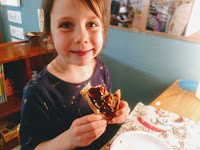My mom, Beate, brought books, pictures, materials, traditional food, colorful stories and a little craft with her.
We learned about famous castles and old architecture, kings, cobble stone paths, fairy tales, and that Southern Germany looks a lot like Vermont!
Children in Germany do not eat a closed peanut butter and jelly sandwich, they eat an open sandwich with butter and jam. We modeled spreading butter and jam on a piece of bread and the Kindergarteners prepared and enjoyed their own German sandwich.
Holding their piece of bread, they spread a generous amount of butter from the middle to the edges. Then they chose between plum or rose hip jam. It was a sweet and delicious morning snack.
Of course, we can't learn about Germany without practicing vowel sounds. In the fourth picture, the Kindergarteners are practicing German vowel sounds. Their facial expressions look about right.
Below you can see children enjoying our snack of bread, butter and jam.





Using some of the details we noticed in German houses- and other loved and colorful symbols and lines- the children decorated wooden birdhouses my mom brought us. We tied up the birdhouses with a piece of forsythia for the children to bring home.
We ended our day celebrating warm weather and community by cleaning and raking our little playground and happily clutching forsythia branches!
It was a true joy to have my mom visit our classroom and share information and stories with us. While I don't have a picture of our lunch, my favorite image of the day was all of the Kindergarteners squished around my mom at the lunch table. She will have to visit again before the end of the school year.






















































